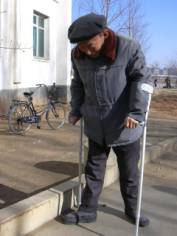|
|
Disabled at Work
Hidden Cost of Jobs for Older Americans
University of Michigan
April 19, 2005

About one-third of all disabled people in their 50s-and half of all disabled men-became disabled because of their jobs, a new study shows.
The finding supports what many weary older workers have long suspected: that work may compromise their health and that postponing retirement may carry hidden costs.
The study was conducted by economists Robert Reville at the RAND Corporation Institute for Civil Justice (ICJ) and Robert Schoeni at the University of Michigan Institute for Social Research (ISR).
"Workplace injuries not only affect the lives of injured workers but translate into higher costs to government programs such as Medicare and Social Security Disability Insurance," said Schoeni, a senior researcher at the ISR. "Society needs to make greater investments in improving workplace safety and in facilitating recovery when injuries do occur."
Reville and Schoeni estimate that the annual cost of workplace injuries to Medicare and Social Security Disability Insurance exceeds $33 billion a year.
"As government and society look for ways to address the growth in Medicare spending, changes in workplace policy should be considered," said Reville. "These issues have become more salient over the last decades as workers are staying in the labor force until older ages, and injuries that occur at older ages have been shown to have more disabling consequences."
Their analysis was based on data from two sources: the ISR Health and Retirement Study, a nationally representative study of the U.S. population age over age 50, funded by the National Institute on Aging, and the Survey of Income and Program Participation, conducted by the U.S. Census Bureau. The analysis, to be published in the forthcoming issue of the Social Security Bulletin (Vol. 65, No. 4), was also supported by the RAND Institute for Civil Justice and the National Institute on Aging.
The researchers found that in the general population aged 51-61, 20.5 percent had a health problem that limits the amount or kind of work they can do, with rates the same for men and for women. The rates are much higher for Hispanics and non-Hispanic Blacks, with about 28 percent reporting a condition limiting their ability to work.
Among those who are disabled, 17 percent report that their disability was the result of an accident or injury at work, with an additional 14.7 percent stating that the impairment was due to the nature of their work rather than an accident or injury at work.
"During the past decades, the share of workers in physically demanding jobs has declined," noted the authors. "However, newer occupations may be associated with a different set of health conditions, such as repetitive stress injuries, obesity, and stress-induced mental illness."
The authors also point out that while men have been almost twice as likely as women to become disabled due to work (50 percent compared with 24 percent), this gap is likely to diminish as more women work for longer periods of time.
About 29 percent were enrolled in Social Security Disability Insurance, which is limited to those with "permanent partial disability" caused by chronic, disabling conditions.
"The results of this study suggest that Social Security Disability Insurance is serving as a major if not primary source of insurance for workplace disabilities," Reville said.
"Coordinating the workers' compensation and Social Security Disability Insurance programs likely could yield substantial benefits, because their target service populations overlap," said Schoeni.
|
|



